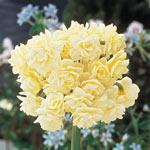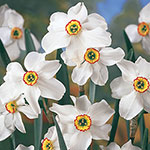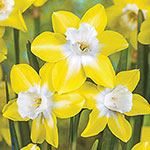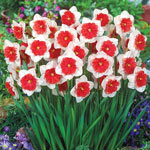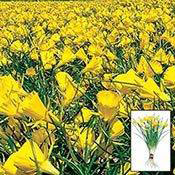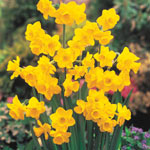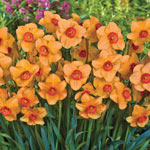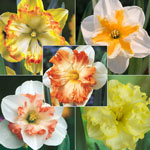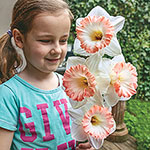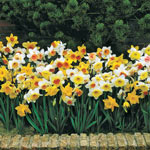Daffodils and daffodil bulbs (narcissus bulbs) feature varieties worthy of their inherent meaning and symbolism, guaranteed to imbue your space with all the beauty and appeal that's expected of them! These prolific daffodils grow tall and straight, have strong stems and dependable blooms.
Daffodil Bulbs (Narcissus Bulbs) From Breck's
Breck's is the best place to buy daffodil bulbs online! Our large selection of daffodils and daffodil bulbs are a spring garden staple and can grow with any spring flower or become a full garden on their own. Find out more about this symbolic flower—from a full
daffodil growing guide to learning about daffodil day.
What are Daffodils?
Daffodils, or narcissus, are a bright and vibrant spring flower that trumpet into any garden. They are known for being easy, reliable and great for beginner gardeners. Daffodil bulbs can be planted in various soil conditions as well as sun or part shade.
Daffodil Varieties
Among the most popular daffodils and daffodil bulbs are classic white and yellow daffodils, but we offer a wide selection of daffodil varieties for your garden. Popular varieties available at Breck's include
double-bloomers, pink daffodils, and many more exciting varieties of this beautiful flower. Our giant daffodils are a show-stopper planted in meadows or tall grasses. For rock gardens and window boxes, we've got some stunning miniature daffodils that'll win a lot of hearts and plenty of adulation! We also carry a wonderful range of
daffodils for naturalizing, plus unusual stand-outs like
Split-corona butterfly and Green-eye daffodils!
Grower's Guide to Daffodils and Daffodil Bulbs
Where to Plant Daffodil Bulbs
A successfully naturalized daffodil field can bloom for up to 30 or even 50 years! First, choose an area with good drainage and sunlight. An area where grass can be left unmown until the foliage has matured is ideal. Hillsides are excellent spots. The edges of woods are also good if you are planting an early-blooming variety that will have a chance to mature before the trees come into full leaf. For best impact, plant drifts of like kinds and colors. Many gardeners "arrange" their drifts simply by taking handfuls of bulbs and throwing them about for a natural-feeling distribution—just dig where the bulbs land!
When to Buy & Plant Daffodils
Daffodils, or narcissus bulbs, are
spring-flowering bulbs and should be planted in the fall. If you're buying daffodil bulbs online, order in August or September for the best selection of daffodils! We'll ship them to you when they're ready to plant. If you plan to buy your bulbs in stores, you'll typically see daffodil bulbs for sale in early fall. Not sure if it's time to plant? Bulbs should typically go in the ground around the first frost date. If you receive your daffodil bulbs early, store them in a cool, dry area until you're ready to plant them.
Naturalizing Daffodil Bulbs
When naturalizing daffodils, you will get the best results and many years of blooms by taking the time to plant properly. For most naturalizing projects, you will be working in uncultivated soil with thick sod, so it is necessary to give each bulb a small custom-cultivated hole. Usually, this means lifting out soil with a spade. One way to make precise bulb holes is to use a
bulb auger or
similar tool—a battery-powered, half-inch drill with a 3" bit usually does the job. Work up the soil from the hole with some peat moss, sand and about a tablespoon of low nitrogen fertilizer. Refill the hole to just below the planting depth with this mix. Next, add one handful of sand and then the bulb (you do not want the bulb in direct contact with the fertilizer). Then fill the hole the rest of the way with sand and replace some of the sod. With a sub-layer of rich, fertilized soil to send roots into, your daffodils will grow even stronger and bloom for years!
Do Daffodils Spread?
Daffodils can multiply in two ways: asexual cloning (bulb division) where exact copies of the flower will result, and sexually (from seed) where new, different flowers will result. Both of these options will produce entirely new plants, but a bloom from a plant grown from seed is about 5 years.
How Long Do Daffodils Bloom?
Daffodil blooms can last up to three weeks when temperatures remain between 45 and 55 degrees Fahrenheit. However, when temperatures rise above 65 degrees Fahrenheit, blooms can only last for a few days.
Do Daffodils Grow Back Every Year?
Like most bulbs planted in the fall, Daffodils will bloom from early to late spring, depending on the weather conditions. Daffodils perform well within hardiness zones 3 to 9. Once blooming is over for spring, allow the leaves to remain on the plant for about six weeks. This period will allow the bulb to absorb nutrients and grow for the following year.
What Does Daffodil Mean?
Owing to their early blooming season, daffodil plants have long served as a symbol of renewal or hope around the world. The gorgeous Daffodils derive their name from Narcissus, the legendary Greek hunter who fell in love with his own reflection—they're that good looking! They have been associated with Easter in the United States, New Year celebrations in Eastern cultures and wedding anniversaries.
Are Daffodils and Jonquils the Same?
All jonquils are daffodils, but not all daffodils are jonquils. Jonquils, or Narcissus jonquilla, have several small flowers per branch, heavy scent, and reed-like, rounded leaves. Jonquils tend to perform best in the South, and in warmer regions. While some call any daffodil a "jonquil," it's a fairly regional use of the term!






